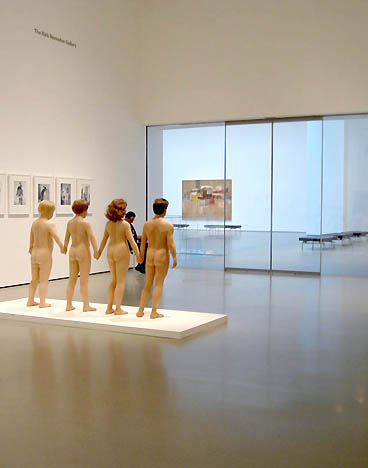Charles Ray. Previously I was only really familiar with his quite disturbing realist sculptures which play on issues of scale ('Family Romance' at the MoMA, NYC comes to mind), but I was never entirely satisfied with the level of detail - especially having subsequently become familiar with the similar work (and potentially similarly overused, even cliched concepts) of Ron Mueck.
 |
| Charles Ray 'Family Romance' 1993, MOMA |
 |
| Ron Mueck 'Two Old Ladies' |
However, this summer, I was absolutely astonished by a more recent Ray piece I saw in the Chicago Art Institute - 'Hinoki', 2007.
At first glance, it simply appears to be a fallen tree trunk. Most visitors passed through at walking pace, looking bemused.
After taking the time to read the information on the wall however, I was astonished. Ray had come across a fallen tree on his way home one day, and had found its form visually arresting. He had the tree cut into slices and transported back to his studio. He wanted to capture its form before it finally decayed away entirely - he had the whole trunk cast with silicone molds, before sending the fibreglass version of the tree to Japan, where he commissioned a master wood carver and his team to precisely replicate it in Japanese cypress wood ('Hinoki').
"At one point, I determined that its armature could be its pneuma, the Greek word for breath, wind, or life. Later, I considered making an inflatable sculpture but realized that the tailoring of the form would bring an unwanted complexity to the surface. It then struck me that the breath or life of the sculpture could be manifested in the very act of sculpting. Making a wood carving of the log by starting from the inside and working my way out would bring a trajectory of life and intentionality to this great fallen tree. With several friends, I transported the tree, cut apart by a chainsaw, back to my Los Angeles studio. Silicone molds were taken and a fiberglass version of the log was reconstructed. This was sent to Osaka, Japan, where master woodworker Yuboku Mukoyoshi and his apprentices carved my vision into reality using Japanese cypress (hinoki). I was drawn to the woodworkers because of their tradition of copying work that is beyond restoration. In Japan, when an old temple or Buddha can no longer be maintained, it is remade. I visited Japan often and had a difficult time bringing this work to completion and allowing it to go out into the world. When I asked Mr. Mukoyoshi about the wood and how it would behave over time, he told me that the wood would be fine for 400 years and then it would go into a crisis; after two hundred years of splitting and cracking, it would go into slow decline for another 400 years. I realized then that the wood, like the original log, had a life of its own, and I was finally able to let my project go and hopefully breathe life into the world that surrounds it."
No comments:
Post a Comment